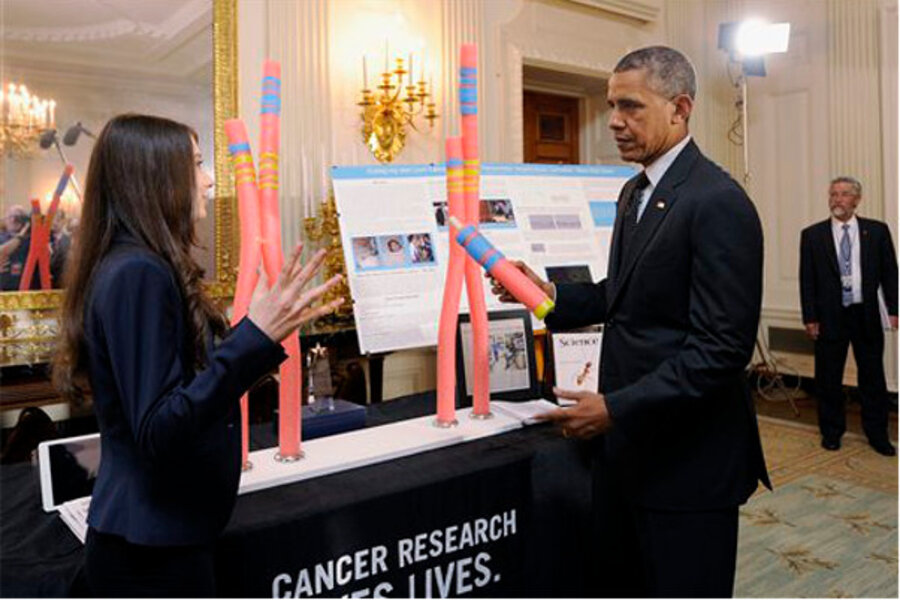Obama attends White House Science Fair. Did anything blow up?
Loading...
| Washington
President Obama hosted the 2014 White House Science Fair Tuesday, and the Executive Mansion remains intact. No experiments exploded or otherwise ignited. Genetically engineered mice did not escape. There was no repeat of the marshmallow cannon incident of 2012, when inventor Joey Hudy’s creation fired sugary treats at a higher rate of speed than administration officials had perhaps anticipated.
However, Mr. Obama remained somewhat wary as he made the rounds and congratulated student scientists. He noted that his own school science experiments had resulted in dead plants and some free-range rodents.
He said, “This is not the blob, is it? This is not going to eat up the White House?” when he dropped a sample of a polymer into a bucket of water at 12-year-old Peyton Robertson’s exhibit.
What’s a polymer? It’s a fancy kind of molecule – you can look it up like we did. Peyton used the substance to design lightweight sand-less sandbags for easier and more flexible protection against flooding. He has won lots of awards and $25,000 for his design. Presumably he got an “A” for the project, as well. See what happens when you’re not satisfied with turning in a baking soda volcano?
The president also appeared to be impressed by a basketball-shooting robot designed by a group of 11- to 14 year-olds from New England. He caught a ball tossed by the machine. When he heard that one of the designers, Daisjaughn Bass, 13, aspired to a basketball career despite parents of middling height, Obama gave some sage advice.
“Keep up with your science homework!” he told Daisjaughn, according to pool reports.
The White House Science Fair appears to be one of the annual public relations duties of the president that he most enjoys. He gets to see fun projects and hang out with Bill Nye the Science Guy and various cast members from "Mythbusters." (This year’s "Mythbuster" was Kari Byron, the woman on the show, which was in keeping with an emphasis on girls in science for 2014.)
“As a society, we have to celebrate outstanding work by young people in science at least as much as we do Super Bowl winners because super-star biologists and engineers and rocket scientists and robot builders, they don’t always get the attention that they deserve, but they’re what’s going to transform our society,” said Obama in his remarks in the White House East Room.
Among the presenters was Elana Simon, 18, who has teamed up with medical professionals to develop data collection techniques for a rare illness with which she is diagnosed, and a group of under-9-year-old girls from Tulsa, Okla., who used Lego blocks to build a prototype flood-proof bridge.
The White House Science Fair is not really a fair – it’s an exhibit. Nobody gets a first-place ribbon. But given the amount of work and ingenuity it takes to get there, they all look like winners. Consider the kid who designed the marshmallow cannon two years ago. Joey Hudy today is a corporate intern at Intel. Did we mention he’s still only 16?








